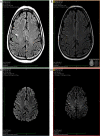A narrative review of central nervous system involvement in acute leukemias
- PMID: 33553361
- PMCID: PMC7859772
- DOI: 10.21037/atm-20-3140
A narrative review of central nervous system involvement in acute leukemias
Abstract
Acute leukemias (both myeloid and lymphoblastic) are a group of diseases for which each year more successful therapies are implemented. However, in a subset of cases the overall survival (OS) is still exceptionally low due to the infiltration of leukemic cells in the central nervous system (CNS) and the subsequent formation of brain tumors. The CNS involvement is more common in acute lymphocytic leukemia (ALL), than in adult acute myeloid leukemia (AML), although the rates for the second case might be underestimated. The main reasons for CNS invasion are related to the expression of specific adhesion molecules (VLA-4, ICAM-1, VCAM, L-selectin, PECAM-1, CD18, LFA-1, CD58, CD44, CXCL12) by a subpopulation of leukemic cells, called "sticky cells" which have the ability to interact and adhere to endothelial cells. Moreover, the microenvironment becomes hypoxic and together with secretion of VEGF-A by ALL or AML cells the permeability of vasculature in the bone marrow increases, coupled with the disruption of blood brain barrier. There is a single subpopulation of leukemia cells, called leukemia stem cells (LSCs) that is able to resist in the new microenvironment due to its high adaptability. The LCSs enter into the arachnoid, migrate, and intensively proliferate in cerebrospinal fluid (CSF) and consequently infiltrate perivascular spaces and brain parenchyma. Moreover, the CNS is an immune privileged site that also protects leukemic cells from chemotherapy. CD56/NCAM is the most important surface molecule often overexpressed by leukemic stem cells that offers them the ability to infiltrate in the CNS. Although asymptomatic or with unspecific symptoms, CNS leukemia should be assessed in both AML/ALL patients, through a combination of flow cytometry and cytological analysis of CSF. Intrathecal therapy (ITT) is a preventive measure for CNS involvement in AML and ALL, still much research is needed in finding the appropriate target that would dramatically lower CNS involvement in acute leukemia.
Keywords: Acute leukemias; central nervous system involvement (CNS involvement); clinical management; pathophysiology.
2021 Annals of Translational Medicine. All rights reserved.
Conflict of interest statement
Conflicts of Interest: All authors have completed the ICMJE uniform disclosure form (available at http://dx.doi.org/10.21037/atm-20-3140). CT serves as an unpaid editorial board member of Annals of Translational Medicine from Nov 2019 to Oct 2021. The other authors have no conflicts of interest to declare.
Figures
References
Publication types
LinkOut - more resources
Full Text Sources
Other Literature Sources
Research Materials
Miscellaneous


